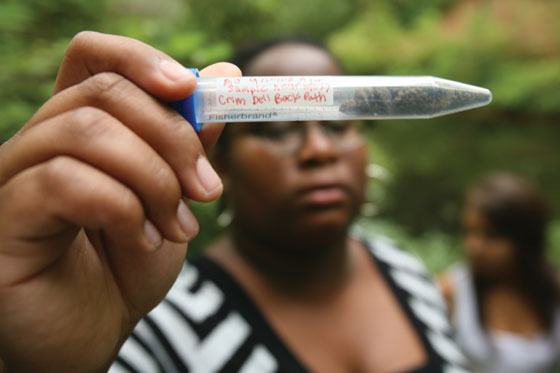Undergraduate Research in the ISC: On the trail of the bacteriophage
Room 3033 in the Integrated Science Center 1 is a nice, new lab. It’s spacious, too—or so it seems until you fill it with 15 freshmen, a handful of TAs, three professors and what everyone hopes will turn out to be a few billion phages.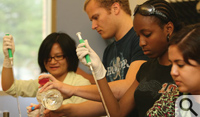
Phages, more formally known as bacteriophages, are viruses that infect bacteria. In recent years they have become a hot topic in ecological studies, while the viral organisms also show promise in the clinical arena as a possible alternative to antibiotics. At William and Mary, phages are the focus of a two-semester freshman research course, sponsored by the Science Education Alliance of the Howard Hughes Medical Institute (HHMI).
William and Mary is one of only a dozen schools nationwide that HHMI chose to participate in its Phage Genomics Research Initiative. Biologists Margaret Saha and Mark Forsyth are conducting the course. They are joined by virologist Kurt Williamson, a new faculty member in biology and a phage specialist.
The HHMI initiative is designed to give freshmen in-the-lab familiarity with the techniques and concepts used in microbiology, molecular biology, genomics and bioinformatics. The students are not just learning advanced biological concepts, but also are working to create new knowledge about phages and their genetic structure.
“It’s real research,” Saha said, surveying the lab filled with freshmen plying test tubes and pipettes. “It’s not just instructional. It’s not research-like. These people are doing real research.”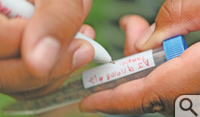
The experiment
The course is devoted to the identification and the genetics of phages in soil and fresh water. The process began with collection of samples from around campus, the students fanning out armed with collection kits and GPS units. This first part is literally as simple as scooping up dirt and putting it into a test tube. The sampling site is marked by a small flag on a stick.
“This label says ‘Please do not touch. Experiment in progress.’,” Sam Harvey ’12 said, marking the spot near Crim Dell where he had just collected a soil sample. “We don’t want someone running over it, in case we want to come back to take more samples.” A GPS reading gives the exact location of the site, which is logged on paper.
The class members take their soil samples to the ISC, where the lab works begins. The first step is to separate the phages, not only from the soil or water, but also from their bacterial hosts. It’s a deft bit of laboratory procedure for first-semester freshmen, but it’s only the first step in a process that will include identification of the phage varieties and preparing the phage for the sequencing of its DNA.
“What we’re doing today,” Oscar Alcoreza ’12 explains, as he shakes a test tube, “is isolating the bacteriophages from the soil so that we can analyze them.”
Valerie Villanueva, a senior teaching assistant, outlined the isolation process, which begins with mixing the soil in a tube with a phage buffer, basically a saline/calcium chloride solution.
“When you shake it up, it separates the phage from the bacteria in the soil,” she said. “You let the soil fall down to the bottom by letting it incubate for 20 minutes. The solution at the top is going to be full of phage because they don’t sink to the bottom.”
The isolation process continues through a filtering and culturing process. Williamson said the students will extract liquid from the top of the tube and add to it samples of Mycobacterium smegmatis, a species of bacteria. Finally, they mix in some top agar. (“It’s like jello,” he says.) The mixture is poured into Petri dishes and watched for evidence of phage presence.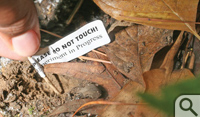
“Without any phages, the bacteria will grow in a continuous lawn. If we do have clear phage infection, there will be clear spots or plaques,” Williamson explained. “That’s what the students are aiming for, to find plaques. With any luck, one of these students could come up with a completely new phage that no one has ever seen before.”
After isolation comes the process of testing and identification—telling one species from another. Finally, a phage will be selected for genetic sequencing, the process of “blueprinting” the DNA of the virus.
“We want to take every single phage isolate and see if we can actually find a phage that infects the bacterium that causes tuberculosis,” Saha said. “This sort of discovery could lead to possible therapies.” She explained that a phage-based TB treatment could be a viable alternative to the use of antibiotics.
Phage therapy
The medical use of phage—using a virus to infect a harmful bacterium—is not new. In fact, the plot of Sinclair Lewis’s 1925 novel Arrowsmith centers on the protagonist’s search for a phage to kill off a strain of the bubonic plague. (Forsyth even re-read Arrowsmith in preparation for the seminar.) In recent years, there has been a renewal of interest in phage therapy, which puts this lab full of first-year William 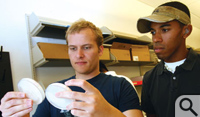 and Mary students very close to the forefront of clinical research, as well.
and Mary students very close to the forefront of clinical research, as well.
“We’re going to choose one phage that actually gets sequenced. All of them are going to be tested,” Saha said. “There is a clinical application that is really important and that motivates a lot of these pre-med students. It’s pretty exciting.”
Forsyth explained that the first semester’s work should culminate with the sequencing of the phage genome. The second semeste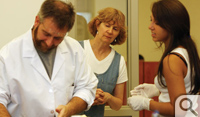 r, he said, will be devoted to the bioinformatic analysis of the genome, the study and annotation of the genes present in the bacteriophage that were collected by students in September.
r, he said, will be devoted to the bioinformatic analysis of the genome, the study and annotation of the genes present in the bacteriophage that were collected by students in September.
“This next stage is even more 21st Century than what we’re doing currently,” he said. “The students’ involvement, contribution and comprehension will each be amplified 10- or 100-fold when we get to the second semester of this seminar.” 














